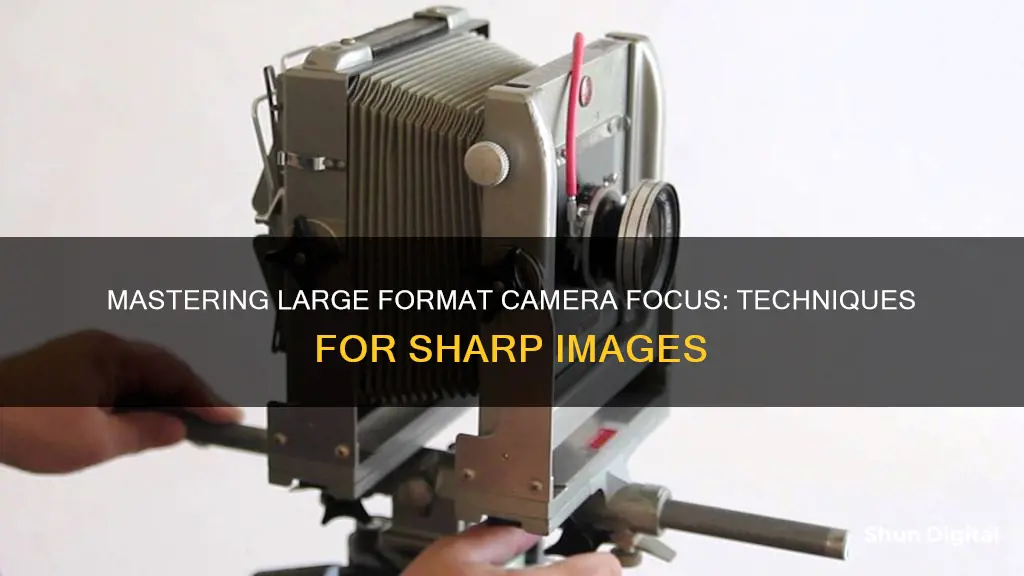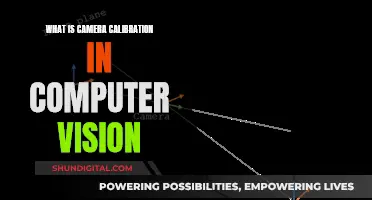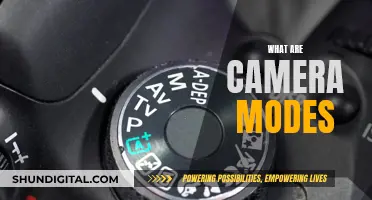
Focusing a large format camera is a complex process that requires a good understanding of optics and the mechanics of the camera. The basic principle is to adjust the distance between the front and rear standards of the camera to bring the image on the ground glass into focus. This can be done by eye or with the help of a magnifier such as a loupe. The focus can be refined by using tilt, swing, or shift movements to manipulate the plane of focus. The Scheimpflug rule states that the film plane, the subject plane, and the lens plane must converge along a single line to achieve maximum sharpness. To achieve this, the tilt of the lens or the angle of the ground glass can be adjusted. Additionally, the use of a metric scale or focus spread method can aid in determining the optimal focus point. Large format photography also requires careful consideration of exposure settings, as the amount of light reaching the film depends on the distance between the front and rear standards.
| Characteristics | Values |
|---|---|
| Method | Visual and iterative |
| Equipment | Metric scale, ideally attached to the camera rail or bed |
| Procedure I | 100% visual, requires some guesswork |
| Procedure II | Requires metric scale, finds the best plane |
| Scheimpflug Rule | Film plane, subject plane, and lens plane must converge along a single line |
| Camera Movement | Depends on the camera back position and desired focus point |
| Hinge Line | Intersection of the plane through the lens center and parallel to the film |
| Depth of Field | A volume around the subject plane, affected by tilts and swings |
| Controls | Front tilt, back tilt, or a combination of both |
| Focus Point | Adjust based on the distance from the camera and composition |
| Aperture | Smaller apertures (e.g. f22, f32) for larger depth of field, avoid f45 and beyond |
What You'll Learn

Use a millimeter scale on your camera
Using a millimeter scale on your large format camera is a great way to focus with precision and ensure that your images are sharp from near to far. Here are some tips on how to use a millimeter scale for focusing:
Choose the Right Scale
Select a millimeter scale that fits your camera. Some large format cameras, such as monorail cameras, come with a built-in millimeter scale. If your camera doesn't have one, you can purchase a scale separately or create your own using a ruler or a printable scale from online resources. Attach the scale to your camera rail or bed using adhesive or velcro, ensuring it doesn't slip during focusing.
Understand the Scheimpflug Rule
The Scheimpflug rule states that for maximum depth of field, the film plane, the subject plane (plane of sharp focus), and the lens plane must converge along a single line. When using a view camera, you can adjust the geometric relationship between the film plane and the lens plane to focus on different planes, such as receding or slanted surfaces.
Procedure I: Focus on Far, Tilt on Near
This method is ideal for photographing flat or planar subjects. First, focus on the farthest point in your scene. Then, use the tilt function to bring the nearest object into focus. You may need to adjust the tilt multiple times to get both the far and near points sharp.
Procedure II: Spread Focus Between Far and Near
This method is useful when dealing with tall or three-dimensional subjects. First, focus on the nearest point and note the position (A) on the millimeter scale. Then, focus on the farthest point and note the position (B). Calculate the difference between A and B, which represents the focus spread. Adjust your tilt or swing to minimize the focus spread, taking measurements after each adjustment. Finally, focus exactly halfway between the nearest and farthest points to maximize depth of field.
Use a Loupe or Magnifier
When focusing, use a loupe or magnifier to precisely judge the sharpness at different points in your scene. This is especially important in large format photography, where depth of field is thin, and slight adjustments can make a significant difference in the final image.
Consider Camera Movements
In addition to focusing, consider using camera movements such as rise, fall, shift, tilt, and swing to refine your composition and maximize depth of field. These movements allow you to adjust the position and angle of the lens and film plane relative to each other, giving you greater control over the final image.
Finding the Synchronize Button in Camera Raw: A Quick Guide
You may want to see also

Focus with the knob
Focusing a large-format camera can be done in a variety of ways, depending on the photographer's experience and the equipment available. One common method involves using the focusing knob to adjust the focus. Here are some detailed instructions on how to focus a large-format camera using the knob:
- Choose a suitable subject: Select a scene that you want to capture with your large-format camera. This could be a landscape, a still life, or any other subject that inspires you.
- Set up your camera: Ensure your large-format camera is securely mounted on a tripod. Adjust the height and position of the camera to frame your chosen subject.
- Focus on the farthest point: Look through the viewfinder or ground glass and identify the farthest point in your composition that you want to be in focus. This could be a mountain, a building, or any distant object.
- Adjust the focus knob: Once you have determined the farthest point of focus, turn the focus knob on your camera to bring that point into sharp focus. This may involve adjusting the lens or the film plane, depending on your camera's design.
- Fine-tune the focus: After focusing on the farthest point, you may need to make adjustments to ensure the nearest objects are also in focus. This can be done by slightly tilting the lens or film plane, known as the "front standard tilt" or "rear standard tilt," respectively.
- Use a loupe or magnifier: If needed, use a loupe or magnifying glass to check the focus on the ground glass. This can help you ensure that both the farthest and nearest objects are sharply focused.
- Repeat as needed: Depending on the complexity of your scene, you may need to adjust the focus knob and tilt settings several times to achieve the desired result. Don't be afraid to experiment and make minor adjustments until everything looks perfect.
- Lock the focus: Once you are satisfied with the focus, remember to lock it in place to prevent accidental adjustments. On most large-format cameras, there will be a locking mechanism to secure the focus settings.
- Compose and capture: With your focus set, you can now compose the rest of your image and capture the photograph. Remember to consider other factors such as lighting, exposure, and composition to create a stunning large-format image.
Remember that practice makes perfect when it comes to focusing a large-format camera. Each camera model may have unique features and controls, so take the time to familiarise yourself with your equipment. With patience and experimentation, you'll be able to master the art of focusing and create beautifully sharp images with your large-format camera.
Travel Light: Camera Gear, Luggage Insert
You may want to see also

Use a loupe to focus
A loupe is an essential tool for focusing a large format camera. It is a magnifying glass that helps you to see the ground glass more clearly and, therefore, focus more accurately. The loupe's magnification power should be tuned to the focusing screen to avoid showing the screen's texture while producing a larger image to aid the focusing process.
To use a loupe, place it against the ground glass and focus on the ground glass texture. You can then lock the loupe's focus or tape it in place. This ensures that the loupe is always at the right distance from the ground glass, which is especially helpful if your eyes struggle to adjust.
When focusing, it is important to note that the image is formed on the ground glass side. Therefore, when using a loupe, you are focusing on the "grains of the ground glass side of the image". This is where the film plane is and where the film will end up when inserted, so this is the most critical location of focus.
Some loupes have adjustable focus, allowing you to change the distance between the ground glass and the loupe. This is particularly useful if your eye struggles to focus at a certain distance. However, even without this feature, a loupe will help you focus more accurately by magnifying the ground glass.
You can also use reading glasses for ground glass viewing and rough focusing. Some photographers forgo a loupe altogether and focus by eye, but this can lead to focus issues that a loupe could have helped avoid.
In addition to a loupe, you will also need a stable tripod to shoot with. Sharpness-robbing vibrations can ruin your shots, so it is important to ensure your camera is secure.
Analog Cameras: Still Relevant, Still Made?
You may want to see also

Adjust the tilt
The tilt adjustment is used to control the orientation of the plane of focus (PoF) and, therefore, which parts of an image appear sharp. The tilt adjustment is particularly useful for landscape photography, as it allows photographers to keep the ground in focus from the foreground to the background.
To adjust the tilt, first, choose a near point (top of the ground glass) and a distant point (middle/bottom of the ground glass) that are both in the plane of focus and have good contrast to focus on. Next, focus the camera on the farthest point from the subject. Then, use the tilt adjustment to make the near point sharp. You may need to augment the tilt and use a little rise to regain your composition. Now, check if the far point needs to be refocused. If so, you will need to repeat the process. Usually, a couple of iterations will be sufficient. This procedure will continuously increase the tilt. The more tilt you need, the more iterations you will have to perform.
Some photographers prefer to focus on the near point first and then perform the tilt to focus on the far point. This method is more suitable for axial tilt. The previous method is more suitable for base tilt.
It is important to note that front and rear standards can be tilted. Front standard tilt preserves the linear structure, keeping verticals parallel. Rear tilt causes the foreground to "loom" and look larger, making the near-far relationship more dramatic.
There are two types of tilt mechanisms on large format cameras: axis tilt and base tilt. Axis tilt, also known as axial tilt, is when the tilting mechanism is on an axis through the middle point of the lens. Base tilt is when the tilt axis is at the bottom of the front standard. If your camera has base tilt, tilting the lens will change the focus, and you will have to refocus the camera with each increment of tilt. You may also need to use some rise to correct the composition. Axis tilt does not affect focus in the same way, so it is quicker to use. Most field cameras have base tilt because it is incorporated into the folding mechanism of the camera.
How to Keep Date and Time Settings on Canon A560
You may want to see also

Use the Scheimpflug rule
The Scheimpflug rule, named after Austrian Army officer Theodor Scheimpflug, is a fundamental concept in optics that provides a systematic approach to achieving extended depth of field in photographs and precise focus control in optical systems. Here are some key points to understand and apply the Scheimpflug rule in large-format photography:
- Understanding the Scheimpflug Rule: The Scheimpflug rule states that the film plane (image plane), the subject plane (plane of sharp focus), and the lens plane (the plane through the optical centre perpendicular to the lens axis) must converge along a single line. This rule allows photographers to bring multiple planes within a scene into simultaneous focus, which is particularly useful in macrophotography, landscapes, and technical imaging applications.
- Application in Large Format Photography: The Scheimpflug rule is especially valuable in large format photography when capturing expansive scenes with diverse depths, such as landscapes or architectural compositions. By tilting the lens and image plane, photographers can achieve a tilted depth of field, ensuring that both foreground and background elements are sharply focused. This technique is also useful for correcting perspective distortions in architectural photography, keeping vertical lines straight.
- Visual Techniques for Focusing: There are various visual techniques for focusing a large format camera using the Scheimpflug rule. One common method involves focusing on the far point and then adjusting the tilt to sharpen the near point. This process may require a few iterations to achieve the desired focus. Another technique is to use a metric scale attached to the camera rail to measure the difference between the near and far focus points, allowing for more precise adjustments.
- Determining the Plane of Focus: Estimating the best plane of focus can be challenging, especially when dealing with three-dimensional subjects. In such cases, the Scheimpflug rule provides a guideline: the subject plane (plane of focus) is where the depth of field behind that plane remains double the distance of the depth of field in front. This helps photographers determine the optimal plane to keep the majority of the scene in focus.
- Tilt and Swing Adjustments: When using the Scheimpflug rule, adjustments to the tilt and swing of the lens are crucial. Tilt refers to rotating the lens about its horizontal axis, while swing refers to rotating it about its vertical axis. These adjustments are used to align the focal plane with the desired area of focus. Small adjustments of a few degrees are usually sufficient, and it's important to consider the composition and aesthetic considerations when making these adjustments.
- Considerations and Limitations: While the Scheimpflug rule is powerful, it's important to be aware of its limitations. It may not be necessary to use extreme lens movements, as subtle adjustments are often sufficient. Additionally, the rule assumes a need for a photo to be in focus from the camera back to infinity, which is rarely the case in practical situations. Remember that depth of field is also influenced by aperture settings.
Camera Batteries: Circuitry Control for Power Performance
You may want to see also
Frequently asked questions
The Scheimpflug rule states that the film plane, the subject plane, and the lens plane must converge along a single line. This means that the plane of best focus runs through your feet, giving you perfect focus from infinity at the top of the frame to your feet at the bottom.
The normal working apertures for 4x5 format are between f16 and f32. Diffraction in 4x5 isn't really noticeable until f64, so it's best to avoid apertures of f45 and beyond unless necessary.
The best way to focus a large format camera is to use a millimeter scale on your camera. This is because there are so many variables with large format lenses, and camera manufacturers have omitted any sort of scale for focus.
The focus spread method is a way to dial in the focus with more precision. It involves finding the furthest and closest objects in your scene and recording the readings on a millimeter scale. The difference between these two readings is the focus spread. To get everything in focus, place the focus exactly halfway between those two readings and stop the lens down according to an acceptable or optimal aperture.







